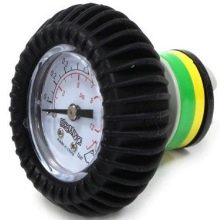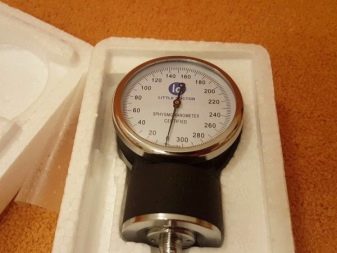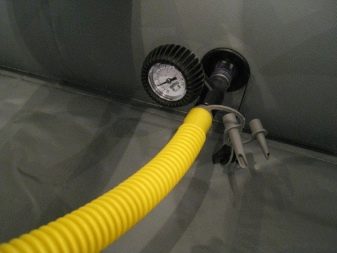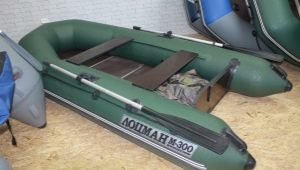Boat pressure gauges: features and manufacturers rating

If you love outdoor activities like inflatable rafting, you know how important it is to maintain accurate air pressure in your tanks. Manometer - a device designed to determine the exact pressure. What varieties of it can be found on today's market, how to choose and install this device on a PVC boat - you will find out the answers to these questions by reading the article.
Brief description and principle of operation
The principle of operation of such devices is based on the deformation of an elastic material under the influence of a gas or liquid, which is converted by a special mechanism into the movement of an arrow along a circular dial. The scale is double - it shows pressure and temperature, because everyone knows the dependence of these indicators on each other. With a decrease in temperature, the air pressure also drops sharply, and with an increase, vice versa. There are cases of explosion of pumped cylinders in the heat.

Pressure gauges for inflatable boats are divided into 3 types:
- verification;
- walk-throughs;
- universal.
The former are designed to control the pressure in the cylinders of the watercraft while moving across the reservoir, the latter only during the period of pumping air into the boat's tanks, and the universal ones combine both of these abilities.
It is preferable to purchase universal devices - this will allow you to constantly be aware of the technical condition of the boat.



Installation
The process of mounting a pressure gauge on a boat is not particularly difficult. You just need to connect the fitting of the device to the valve. If the pressure gauge and the cylinder valve do not match, it is necessary to purchase or make a simple adapter in the form of a tube with different diameters, suitable in size for the inlets of the devices. If you purchase a pressure gauge in a specialized store, the complete package usually includes an instruction manual that fully describes the installation process, and a set of adapters.
After installing the device, be sure to test its operation - start pumping up the boat and follow the readings of the device. Then stop the pump and disconnect it.
If the pressure gauge starts to bleed air (this is noticeable by the arrow, which begins to slowly move in the opposite direction) - there is a malfunction of the device or an incorrect (leaky) connection.



How to choose?
Today on the market you can find a huge number of the most diverse models of pressure gauges from manufacturers from around the world. But remember that not every device is right for you: there are some criteria for the compatibility of pressure gauges and inflatable boats. First of all, you should pay attention to the type of valve of the craft itself. Of course, there are also special adapters on sale for connecting to the wrong type of valve, but this only multiplies the essence unnecessarily. It makes sense to purchase such adapters if you already have a pressure gauge that is not compatible with the next purchased boat.
Secondly, pay attention to the type of device.The most preferred, as mentioned above, are universal pressure gauges. The third important criterion is the quality of the product. Here you need to focus on the popularity of the manufacturer and reviews of its products. By the way, The most popular boat pressure gauges are Bravo brand instruments. The range and accuracy of measurement is the fourth criterion by which you should evaluate the proposed purchase.
The dimensions of the device can also affect your choice - the smaller the device, the easier it is to find a place for it and install it. Last but not least, you should pay attention to the cost of the device, sometimes it is unreasonably high. But you should not take too cheap products, unless, of course, you need a device for one-time use.


How to do it yourself?
A boat pressure gauge is not such a complicated device, therefore, if desired and with little experience with hand tools, it can be made at home. For this you will need:
- used blood pressure monitor (in working condition);
- branch pipe from the pneumatic pump to the valve of the boat tank;
- polyvinyl chloride tube, the diameter of which must be suitable for connecting the tonometer and the pipe;
- a metal-plastic tube, the outer diameter of which should be just a little less than the inner diameter of the pipe;
- a small piece of millimetric steel wire or a piece of a nail of the same diameter.


Connect the tonometer to the pump nozzle through a PVC pipe. Insert a metal-plastic tube into the pipe, into the end of which a piece of wire (nail) is previously glued across the diameter.This piece of steel will serve as a kind of button, when pressed, the boat's reservoir valve will open for measurements. That's all. But remember that such a handicraft device must be protected from contact with water, since its design is not waterproof.
Another point - the tonometer scale shows the pressure in millimeters of mercury. Don't forget to convert them to units that are more convenient for you. Preliminary coloring of the scale according to the zones of ideal, normal and unacceptable pressure will make it easier for you to use a home-made device - while swimming, you will not need to frantically convert mm of mercury to millibars in order to understand whether the pressure in your cylinders is acceptable or not. This is especially true for rafters.


In the next video, you will test pressure gauges for a PVC inflatable boat.




























